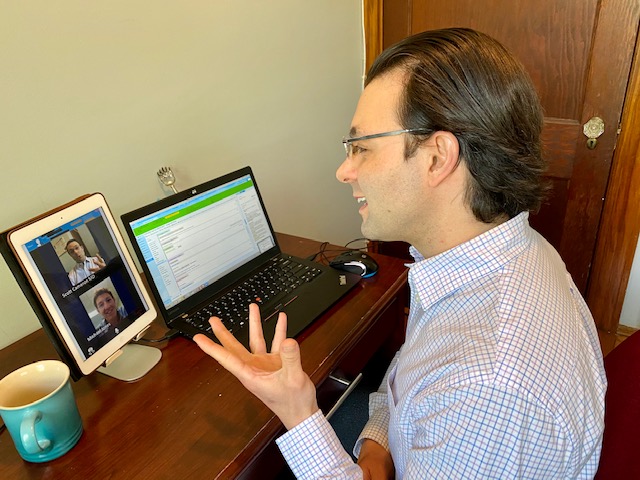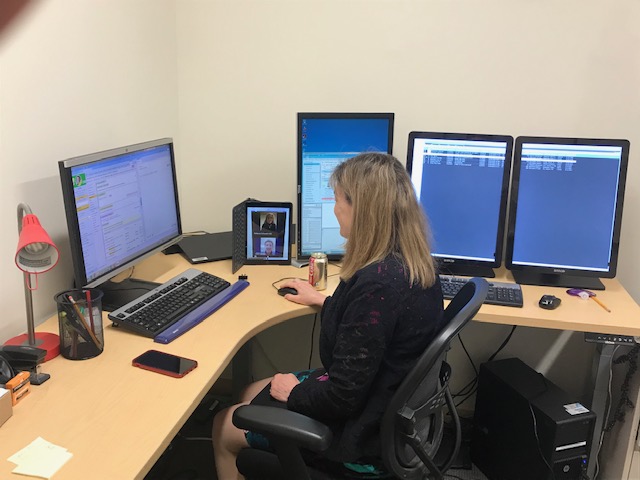Photo caption: Scott F. Cameron, MD, conducts a video visit from his home office.
During the first six weeks of the COVID-19 pandemic, we had a rare opportunity to work as primary care telehealth providers. Although our training is similar to that of most of the radiologists in this country, we volunteered to perform primary care video visits specifically for suspected COVID-19 patients in our health system. In doing so, we learned more about ourselves as physicians and about the patient-physician relationship that will forever change our practice of radiology.
Atrius Health, Inc., a multispecialty, next generation accountable care organization, became inundated with patient phone calls during the onset of the pandemic in March. With approximately 1,000 physicians and advanced practice providers caring for over 700,000 patients, we are responsible for the health of approximately 15% of the residents of eastern Massachusetts. Amidst the growing pandemic and the rapid decline of in-person visits, a previously developed, but little used, telehealth platform was deployed to bridge the gap for many worried, symptomatic patients. The majority of the telehealth providers were physicians and advanced practice providers from the primary care department. Others, as has been the case in other institutions, were from specialty departments such as orthopedics, podiatry, and OB/GYN.1,2 We were the two radiologist volunteers.
Armed with several hours of detailed, hands-on technical training, including demonstration with a simulated patient, we learned how to conduct the coronavirus video visit. Material covered in the visit included the clinical presentation of COVID-19, broad criteria to use as decision support for where to triage a patient as a result of the visit, and a differential diagnosis for common respiratory and systemic symptoms. The limited physical examination included the patient’s self-assessment of their heart rate, abdominal tenderness, and cervical lymphadenopathy, plus our observations of the patient’s general comfort, any eye redness, cough, wheezing, and shortness of breath. Patients were triaged to at-home care, testing when appropriate, or in-person care. Over-the-counter treatments were recommended, and prescription medications were prescribed when needed. The patient’s primary care provider was copied on encounter notes to ensure safe follow-up.
We were both surprised to see how quickly we adapted to this new role. We learned the mechanics and nuances of post-visit documentation and charting. We reviewed common over-the-counter treatment strategies for respiratory symptoms and antibiotic regimens for common coincident bacterial infections. Performing these video visits required us to dig deep into our general medical knowledge. We persisted, despite some uncertainty and discomfort — sensations relatively foreign to us given the number of years we have practiced radiology. The liability protections for healthcare workers providing COVID-19-related diagnosis and care during the state of emergency passed in Massachusetts in April and provided us with some comfort.3
Despite the stress of assuming a new role on essentially a day’s notice, the increased patient contact was invigorating.
Despite the stress of assuming a new role on essentially a day’s notice, the increased patient contact was invigorating. Connecting with patients in their home environment grants an unusual window into the social determinants of health that deeply affect patient care, including imaging, but are often invisible to us as radiologists. Performing video visits with patients to discuss imaging findings — for example, low-dose chest CT for lung cancer screening — might afford radiologists the same opportunity to understand their patients’ medical conditions in the context of their lives.
Working in telehealth also gave us newfound respect for our primary care colleagues. Their charting and documentation requirements stand in contrast with radiology’s powerful voice recognition programs and extensively templated reports tailored to meet billing requirements. The emotional wear and tear of helping sick patients, hour after hour, face-to-face, can compound the mental challenges of dealing with medically complex patients. Radiologists often lament inadequate histories and inappropriate choices of imaging exams submitted by ordering providers. We never understood before why the few extra clicks involved in submitting information to a CDS module might be so onerous. Walking for a few weeks in the ordering provider’s shoes fosters a better appreciation of the challenges of the internist’s work life and a greater desire to simplify their interactions with the radiology department — perhaps by promoting process-improvement projects and AI applications.
Above all, we gained a respect for the ability of a crisis to accelerate progress. A crisis such as this is devastating for patients and the population at large. It can also provide radiologists with unique opportunities for service, institutional collaboration, and lessons learned that will endure and enrich their perspectives and performance in the care of their patients.
|
Rebecca K. Schwartz, MD, chief of the department of radiology at Atrius Health Inc., conducts the coronavirus video visit. |


